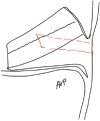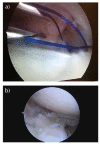Arthroscopic repair of the meniscus: Surgical management and clinical outcomes
- PMID: 30595844
- PMCID: PMC6275851
- DOI: 10.1302/2058-5241.3.170059
Arthroscopic repair of the meniscus: Surgical management and clinical outcomes
Abstract
From the biomechanical and biological points of view, an arthroscopic meniscal repair (AMR) should always be considered as an option. However, AMR has a higher reoperation rate compared with arthroscopic partial meniscectomy, so it should be carefully indicated.Compared with meniscectomy, AMR outcomes are better and the incidence of osteoarthritis is lower when it is well indicated.Factors influencing healing and satisfactory results must be carefully evaluated before indicating an AMR.Tears in the peripheral third are more likely to heal than those in the inner thirds.Vertical peripheral longitudinal tears are the best scenario in terms of success when facing an AMR.'Inside-out' techniques were considered as the gold standard for large repairs on mid-body and posterior parts of the meniscus. However, recent studies do not demonstrate differences regarding failure rate, functional outcomes and complications, when compared with the 'all-inside' techniques.Some biological therapies try to enhance meniscal repair success but their efficacy needs further research. These are: mechanical stimulation, supplemental bone marrow stimulation, platelet rich plasma, stem cell therapy, and scaffolds and membranes.Meniscal root tear/avulsion dramatically compromises meniscal stability, accelerating cartilage degeneration. Several options for reattachment have been proposed, but no differences between them have been established. However, repair of these lesions is actually the reference of the treatment.Meniscal ramp lesions consist of disruption of the peripheral attachment of the meniscus. In contrast, with meniscal root tears, the treatment of reference has not yet been well established. Cite this article: EFORT Open Rev 2018;3:584-594. DOI: 10.1302/2058-5241.3.170059.
Keywords: arthroscopic repair; meniscus; results; surgical techniques.
Conflict of interest statement
ICMJE Conflict of interest statement: None declared.
Figures







Similar articles
-
Surgical treatment of complex meniscus tear and disease: state of the art.J ISAKOS. 2021 Jan;6(1):35-45. doi: 10.1136/jisakos-2019-000380. Epub 2020 Sep 17. J ISAKOS. 2021. PMID: 33833044 Review.
-
[Adult lateral meniscus].Rev Chir Orthop Reparatrice Appar Mot. 2006 Sep;92(5 Suppl):2S169-2S194. Rev Chir Orthop Reparatrice Appar Mot. 2006. PMID: 17088783 French.
-
The knee meniscus: management of traumatic tears and degenerative lesions.EFORT Open Rev. 2017 May 11;2(5):195-203. doi: 10.1302/2058-5241.2.160056. eCollection 2017 May. EFORT Open Rev. 2017. PMID: 28698804 Free PMC article.
-
Management of traumatic meniscal tear and degenerative meniscal lesions. Save the meniscus.Orthop Traumatol Surg Res. 2017 Dec;103(8S):S237-S244. doi: 10.1016/j.otsr.2017.08.003. Epub 2017 Sep 2. Orthop Traumatol Surg Res. 2017. PMID: 28873348 Review.
-
Arthroscopic meniscal repair with use of the outside-in technique.Instr Course Lect. 2000;49:195-206. Instr Course Lect. 2000. PMID: 10829175 Review.
Cited by
-
Arthroscopic Procedure for Chronic Isolated Bucket-Handle Meniscal Tears.Arthrosc Tech. 2021 Jan 29;10(2):e375-e383. doi: 10.1016/j.eats.2020.10.011. eCollection 2021 Feb. Arthrosc Tech. 2021. PMID: 33680769 Free PMC article.
-
Repair of Radial Meniscus Tears Results in Improved Patient-Reported Outcome Scores: A Systematic Review.Arthrosc Sports Med Rehabil. 2021 May 6;3(3):e967-e980. doi: 10.1016/j.asmr.2021.03.002. eCollection 2021 Jun. Arthrosc Sports Med Rehabil. 2021. PMID: 34195666 Free PMC article. Review.
-
Higher healing rate after meniscal repair with concomitant ACL reconstruction for tears located in vascular zone 1 compared to zone 2: a systematic review and meta-analysis.Knee Surg Sports Traumatol Arthrosc. 2022 Jun;30(6):1976-1989. doi: 10.1007/s00167-022-06862-2. Epub 2022 Jan 24. Knee Surg Sports Traumatol Arthrosc. 2022. PMID: 35072757 Free PMC article.
-
Clinical and MRI Outcomes of Repaired Peripheral Longitudinal Tears of the Posterior Horn of the Medial Meniscus With ACL Reconstruction: Results According to Tear Size.Orthop J Sports Med. 2023 Aug 25;11(8):23259671231167535. doi: 10.1177/23259671231167535. eCollection 2023 Aug. Orthop J Sports Med. 2023. PMID: 37655242 Free PMC article.
-
Earlier Is Better? Timing of Adductor Canal Block for Arthroscopic Knee Surgery under General Anesthesia: A Retrospective Cohort Study.Int J Environ Res Public Health. 2021 Apr 9;18(8):3945. doi: 10.3390/ijerph18083945. Int J Environ Res Public Health. 2021. PMID: 33918626 Free PMC article.
References
-
- Dandy DJ, Jackson RW. The diagnosis of problems after meniscectomy. J Bone Joint Surg Br 1975;57:349–352. - PubMed
-
- Shoemaker SC, Markolf KL. The role of the meniscus in the anterior-posterior stability of the loaded anterior cruciate-deficient knee: effects of partial versus total excision. J Bone Joint Surg Am 1986;68:71–79. - PubMed
-
- Stephen JM, Halewood C, Kittl C, Bollen SR, Williams A, Amis AA. Posteromedial meniscocapsular lesions increase tibiofemoral joint laxity with anterior cruciate ligament deficiency, and their repair reduces laxity. Am J Sports Med 2016;44:400–408. - PubMed
LinkOut - more resources
Full Text Sources

